In 2016 my wife Cathy and I walked Ireland’s Dingle Way, circumnavigating the Dingle Peninsula on foot but without backpacks. Rather than carry all our stuff and camp out — which may not even be possible — we stayed at B&Bs, having dinner and a pint or two at the village pubs, our luggage sent ahead from one stop to the next. It was a delightful way to travel. We enjoyed the scenery at a walking pace, as humans are meant to, but got to eat warm meals, drink cold beer and take hot showers every day. We dealt with some nasty weather on the trail to be sure, but getting soaked is all good fun when you are spending the night in a warm cozy inn, not a cold soggy tent.
We liked this trip so much that of course we wanted to find another slackpacking trail in another distant land. Spain’s Camino or Switzerland’s Mont Blanc circuit were obvious choices, but maybe too obvious. Europe is wonderful, but being European-Americans ourselves, it is also familiar. We wanted something more challenging, at least on the cultural, if not the physical, level.
Japan is about as far away from Ireland, in both culture and geography, as it is possible to get. It also is most definitely a first-world country, which helps a lot if you want to do a slackpack trip but be self-guided. We spent a few winter nights browsing pilgrimages and hikes in Japan and came up with the Kumano Kodo as a likely destination: the distances are not too great (Cathy has no interest in hiking 20 mile days), the trail is scenic and culturally significant, and it offers a chance to experience rural Japan.
The Kumano pilgrimage tradition dates back at least a thousand years, but the religious significance of the area is far more ancient. The principal shrines on the walk (Hongu, Nachi, and Hayatama) were well-established as sites of nature worship when Buddhism came to Japan in the 6th century. Rather than eradicate the autochthonous religion, Buddhism fused with it to create the Kumano religion, assigning the mountain spirits to their own pantheon, and encouraging visits from one mountaintop shrine to another. I suspect this is true of most pilgrim routes: there are some paths, some mountains, some forests, that are just intrinsically spiritual. Dominant religions adopt them and make them their own. That’s how they become dominant.
It was customary for Japan’s rulers to walk the route. They brought along hundreds of retainers, creating a moveable court that catered to their needs. A few emperors even retired from their offices (perhaps with encouragement from rivals) to set up residence and to adopt this path of purification as their home. In any event, a number of villages and tea houses grew up along the route to service those who could not bring imperial retinues along with them.
The modernization/Westernization of Japan after 1868 proved deadly to these establishments. Kumano Buddhism was suppressed, and the mountains were opened for logging to meet the needs of rapid industrial expansion. As with the Tudor Reformation in England, temples were looted and abandoned. A few mountain hamlets hung on, some even into the 1950s, but most were deserted as the pilgrimage tradition withered.
Mountains are patient, though. Humans have sensed the sacred in the Kii mountains for millennia and that sense was bound to emerge again. The dominant material ethos of Japan’s postwar development drive provoked the inevitable opposing reaction. The Kumano tradition began to resurface in the 1990s and by 2004 the Kumano trails were added to the UNESCOs World Heritage list, joining the Camino de Santiago as the only pilgrimage routes so designated.
Our Kumano walk was but one week of a three-week trip to Japan, and so I should say a few words about the country in general. Japan is known for being clean, orderly, and efficient and rightly so. Public transportation is amazing; we never had to walk more than a kilometer in Tokyo or Kyoto to get anywhere. No one jaywalks, a cultural norm that would rob New Yorkers of the will to live. The cleanliness of the streets was not surprising, but we were flummoxed by the absence of trash cans. We often carried our trash around with us the whole day before disposing of it back at our hotel. Public restrooms are sparkling clean, but none have paper towels and only a few have hand-dryers. You have to bring your own towel or settle for shaking your hands dry as best you can.
Few people speak English but most understand a few words, and all are ready to help and accommodate tourists as best they can. Anytime we stood around puzzling over our phones, someone would walk up and offer their help. Elaborate courtesy from clerks, bus drivers, and other service personnel is the norm, and they take genuine pride in doing a good job.
None of this was a surprise. What did surprise us was how cheap it can be to travel in Japan. Although there are plenty of opportunities to drop $100 on a meal or $300 on a room, there is no need. We had dozens of meals for 500–2000¥ ($5-$20). And those cheap meals were usually excellent, being expertly prepared using fresh, high-quality ingredients. Spending money on food in Japan doesn’t buy you better food; it just buys you exquisite table settings and space in a large restaurant; your additional yen are just buying real estate. If you can do without that, you can eat well on the cheap.
We ate mostly in tiny hole-in-the-wall restaurants that line the streets and alleys of residential neighborhoods in the cities and villages. Some of these have no tables or chairs, just a bar where you can stand and order drinks and food. Others have 6–12 seats around a bar or maybe a couple of tables.

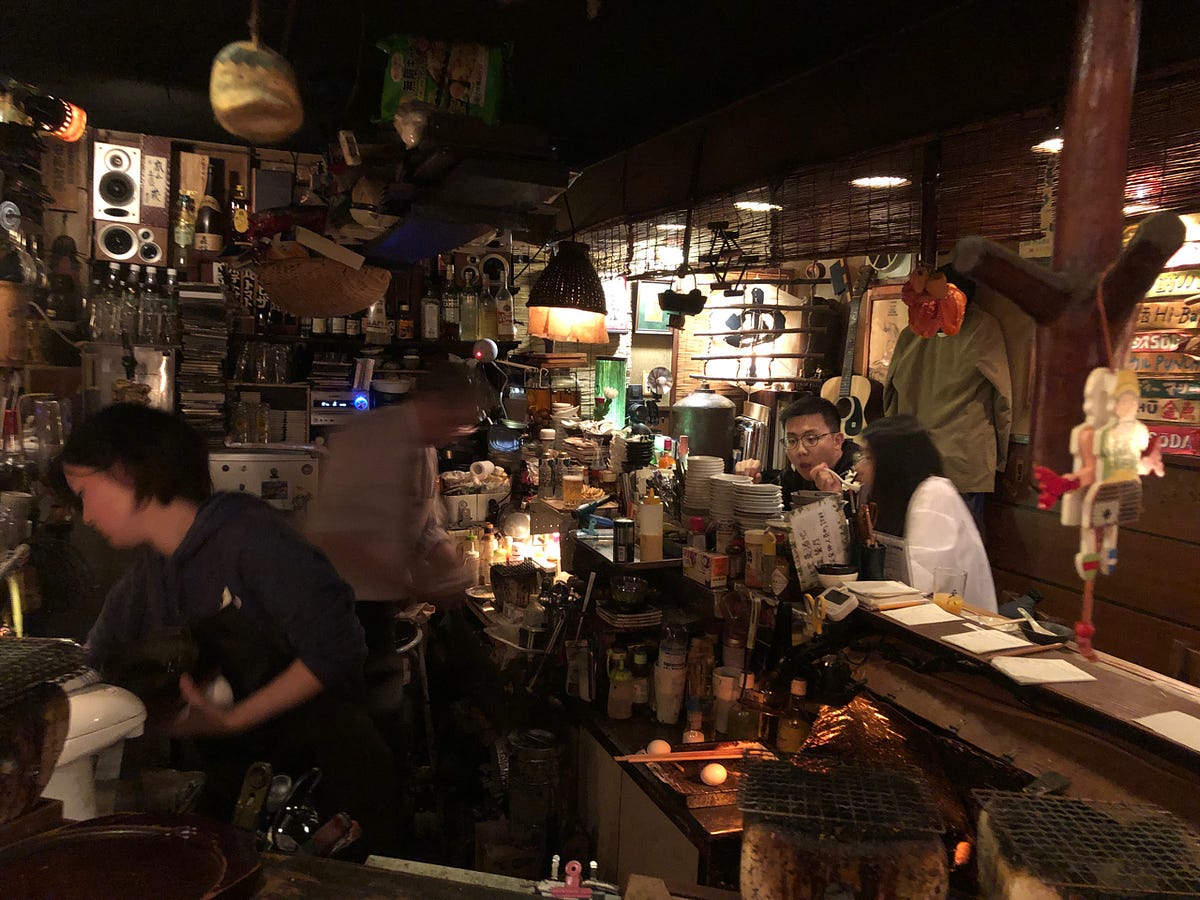
Our experience in Osaka was typical. After seeing a few sights we wandered through back streets in search of okonomi-yaki, sometimes known as Japanese pancakes despite pancakes resembling okonomi the way that minimalist art resembles baroque. I slid open the door to one such place, finding it empty save a middle-aged Japanese woman sitting in the corner watching a game show on the TV. I thought it was not yet open and began to back out, but she waved us in and scooted behind the grill, which was fronted by a bar. We ordered beers (“birru kudasai”) and looked over the English menu. As is typical, the English menu had three items on it while the Japanese menu had about twenty. We tossed the menu aside and through a combination of pantomime and Google translate asked her to cook us her own favorite dish.
She pulled out a tub of okonomi batter (heavily loaded with chopped cabbage) added some vegetables and sauces and lots of mayonnaise, mixed them together and plopped the concoction on the grill in front of us, adding bacon as a topping (can’t go wrong with bacon). She had a handheld translator gizmo and we chatted a bit while the okonomi cooked. The cold Sapporos in our hands made an excellent complement to the hot savory smells wafting off the grill.

Cooking done, she sliced up the okonomi and handed us small spatulas that we used to scoop bites up and off the grill and into our mouths. The flavor was rich and complex, deeply satisfying without being heavy or greasy. We were joined by a Korean student who spoke both English and Japanese, facilitating the conversation, and traded okonomi chunks with him. We left the place an hour or so later with full stomachs and a decent beer buzz, our wallets only lighter by 2400¥ ($24). That kind of eating experience repeated itself throughout Japan.
Our lodgings that night in Osaka were in a capsule hotel downtown. For 2700¥ each, we got a robe and slippers and a locker, and our own capsule — a compartment roughly 4 x 4 x 8 feet. Essentially it was a hostel dorm room bed, only enclosed on all sides. The door on the end is a window shade that rolls up and down. You leave your shoes at the entrance to your floor (men’s and women’s are separate), put on the slippers and change into the robe. The shower room (bright and clean of course) has all the amenities you might want: toothbrushes, toothpaste, soaps, shampoos, deodorant, even hairbrushes being sterilized in a little UV oven. The shared bathroom, for which you take off your hall slippers and put on special bathroom slippers, was equally clean and well-appointed. Everything was super-logical, super-efficient and well-designed. I slept great and awoke ready for the big hike.
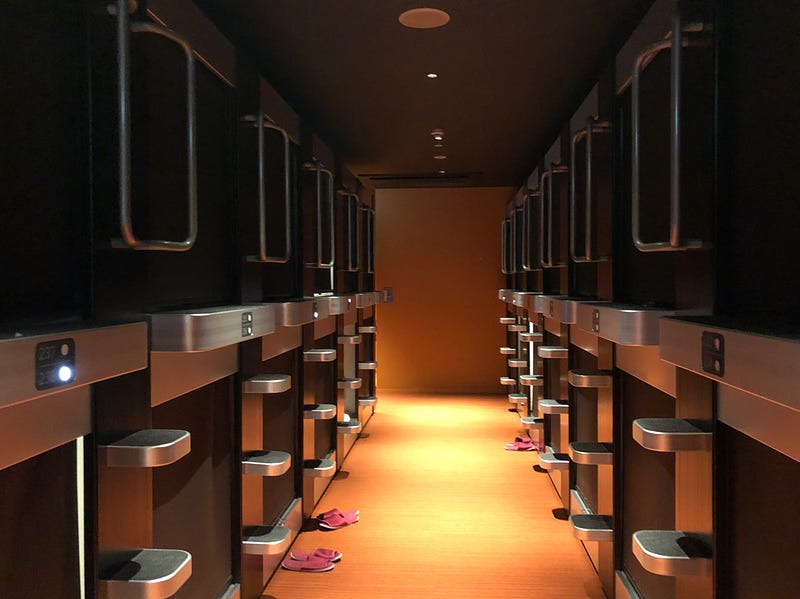


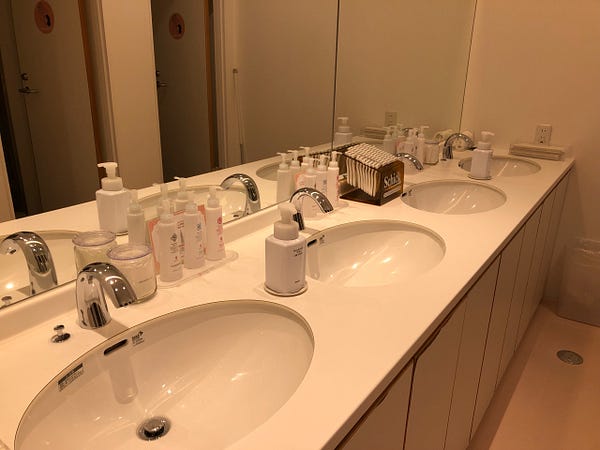
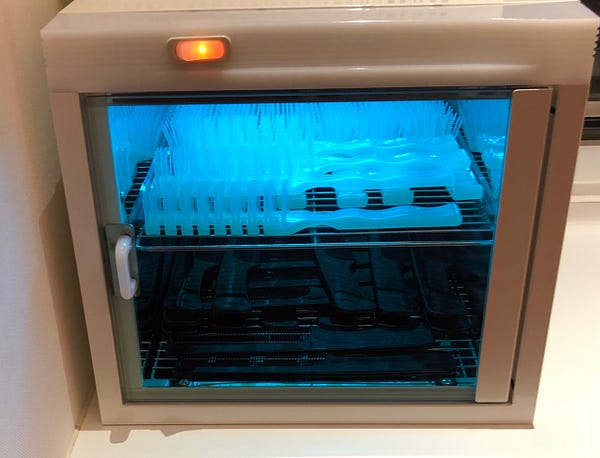

Day 1 — Takijiri to Kurisugawa, 5 km
We left our capsule hotel, went over to the chain hotel next door for breakfast and experienced our one bad meal in Japan. Not only were they serving mealy hot dogs, but the eggs had a sign on them that said “runny scrambled eggs”. At least the management was being honest about serving terrible food.
But no matter. We took a train to Tennoji and then transferred to the limited express train running down the coast to Kii-Tanabe. The outskirts of Osaka persisted well down the coast, an urban corridor that only gradually gives way to small towns and then villages and farms. The farms really looked more like market gardens — plots that produce more food (mostly rice) than needed for family consumption, but which are far too small to be viable stand-alone economic operations. At least in the US; maybe the economics of farming are much different in Japan.
We got off at Tanabe station and located the luggage agent nearby. Japan has a system called takkyubin — often operating out of 7–11 stores — where you can have your luggage shipped ahead rather than drag it along with you on the train. This system simplifies logistics immensely. In Ireland we carried day packs and reunited with our carry-ons at each night’s lodging, courtesy of taxis hired by the tour company for this purpose. But in Japan your need for luggage on the trail is much reduced. The inns supply you with a robe (and slippers of course) to wear during your stay, eliminating the need to pack clean clothes to change into after a sweaty or muddy hike. They supply toiletries as well — one can travel Japan without bothering to pack even a toothbrush. Since the weather was warm, we needed to carry only a rain jacket, a water bottle, clean socks, and undies, all of which fit readily into our daypacks.

With our luggage headed to Nara, we found a grocery store and picked up bento boxes for lunch and then waited for the bus to Takijiri. The bus, filled with a mixture of locals and pilgrims, wound its way up along the Tonda River, a clear stream threading a flat gravel streambed. Steep forested ridges rose straight up from the banks leaving little room for agriculture or for commercial development of any kind, and also creating a sense of isolation from the wider world.
We hopped off the bus, took a turn around the Kumano Kodo information center (helpfully stocked with Montbell hiking gear) and made our way across the street to the Takijiri-Oji, our first shrine and the starting point of the trip.
Although this was hardly a trip into a howling wilderness, I felt the same mixture of excitement and uncertainty that I do with any hike. Every journey has its own mysteries, secret places waiting to be revealed through the magic of walking, the only way to truly immerse yourself in a landscape. We paid our respects to the shrine, took our selfies at the gate, and commenced onward.
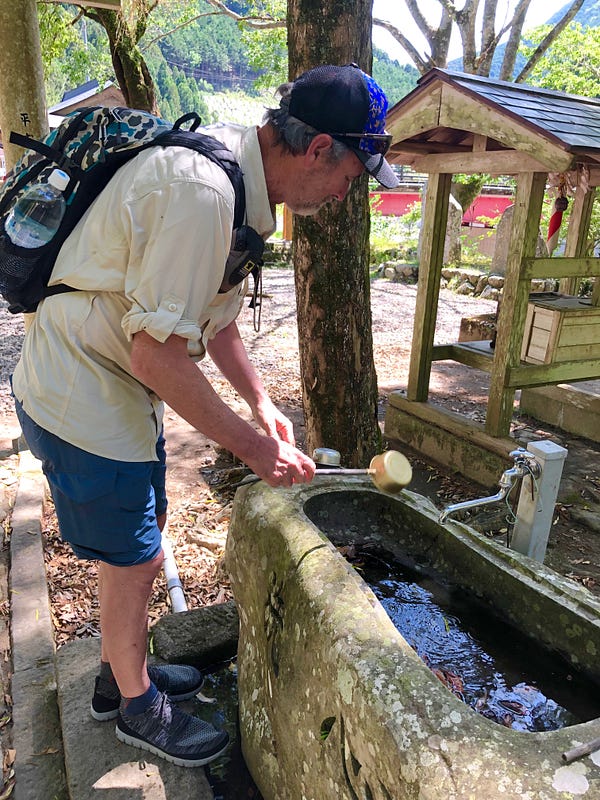
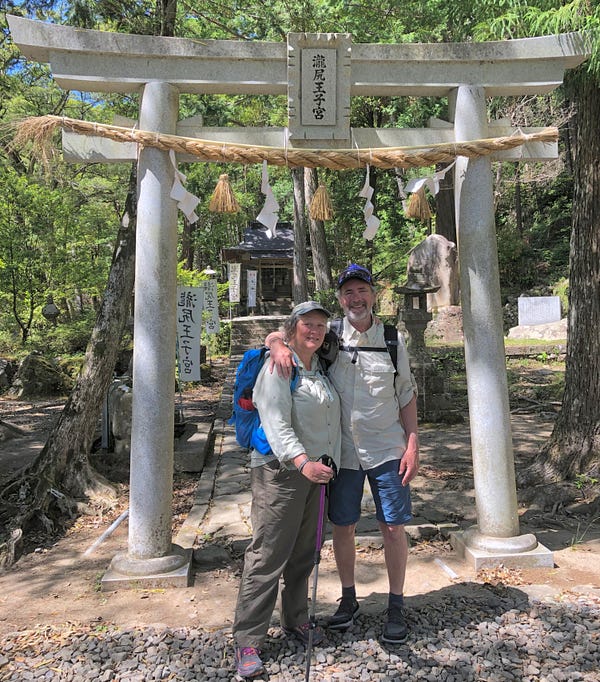
And upward, too. We soon exhausted the narrow margin of flat land bordering the river, and began our climb up the ridge, the trail alternating between carefully placed stone steps and rough root-threaded trail. The climb wasn’t a big one — about 300m — but it was steep.

Cathy had spent the weeks before our trip getting things squared away at work rather than going out for hikes, and she was soon red-faced and puffing in the heat. And a little annoyed to notice that I wasn’t breathing hard at all. I allowed that my heart rate was elevated, but I doubt she found this confession very satisfying.
Our first point of interest was the Tainai Kuguri, a narrow rock tunnel that is navigated by belly-crawl. Tradition has it that women who made it through the womb-like passage were assured of an easy labor. Not being 100-pound Japanese peasant women, we found it quite the squeeze and had to remove not only our backpacks but to empty our pockets as well.
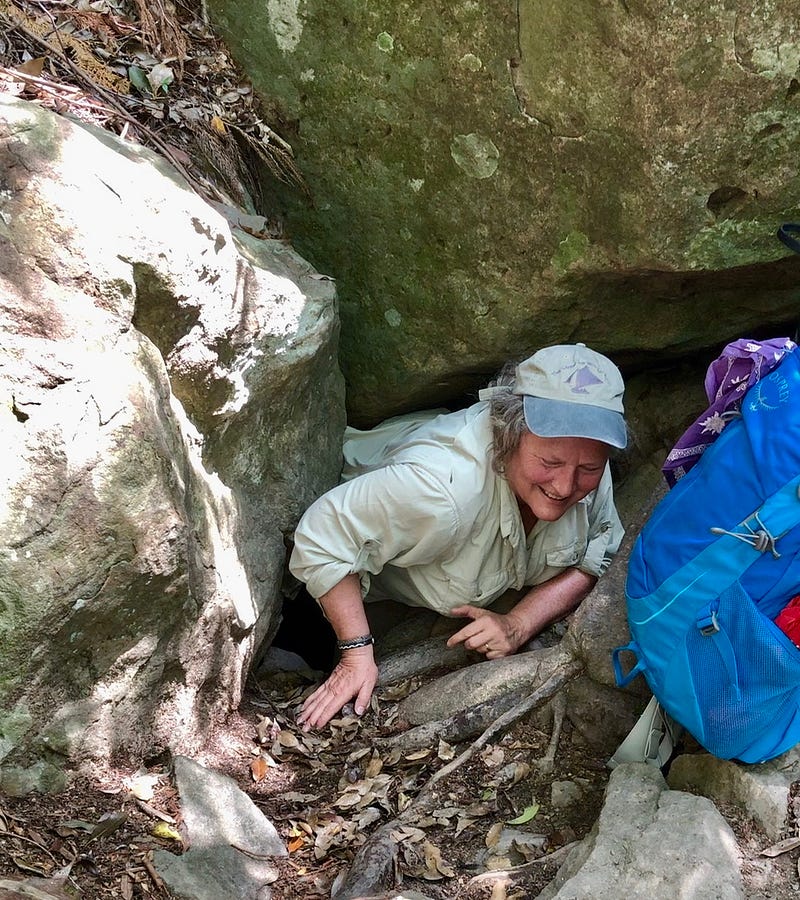

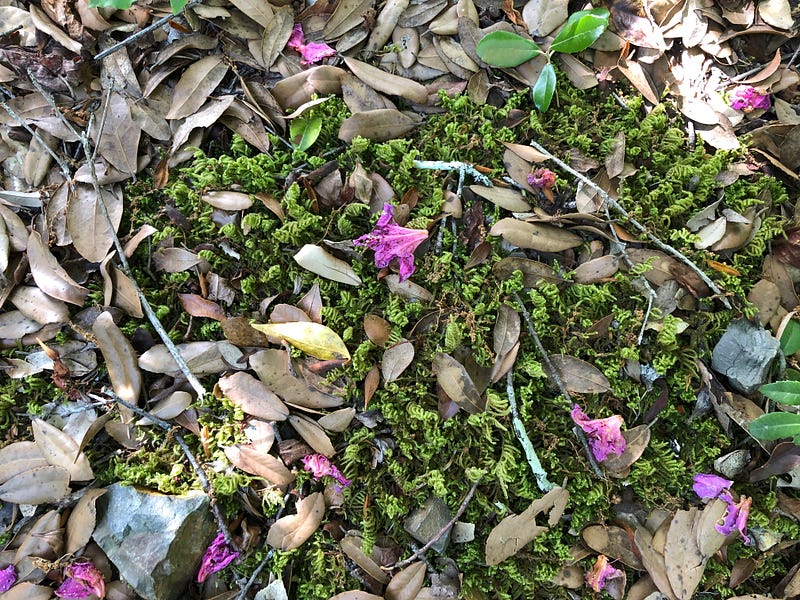
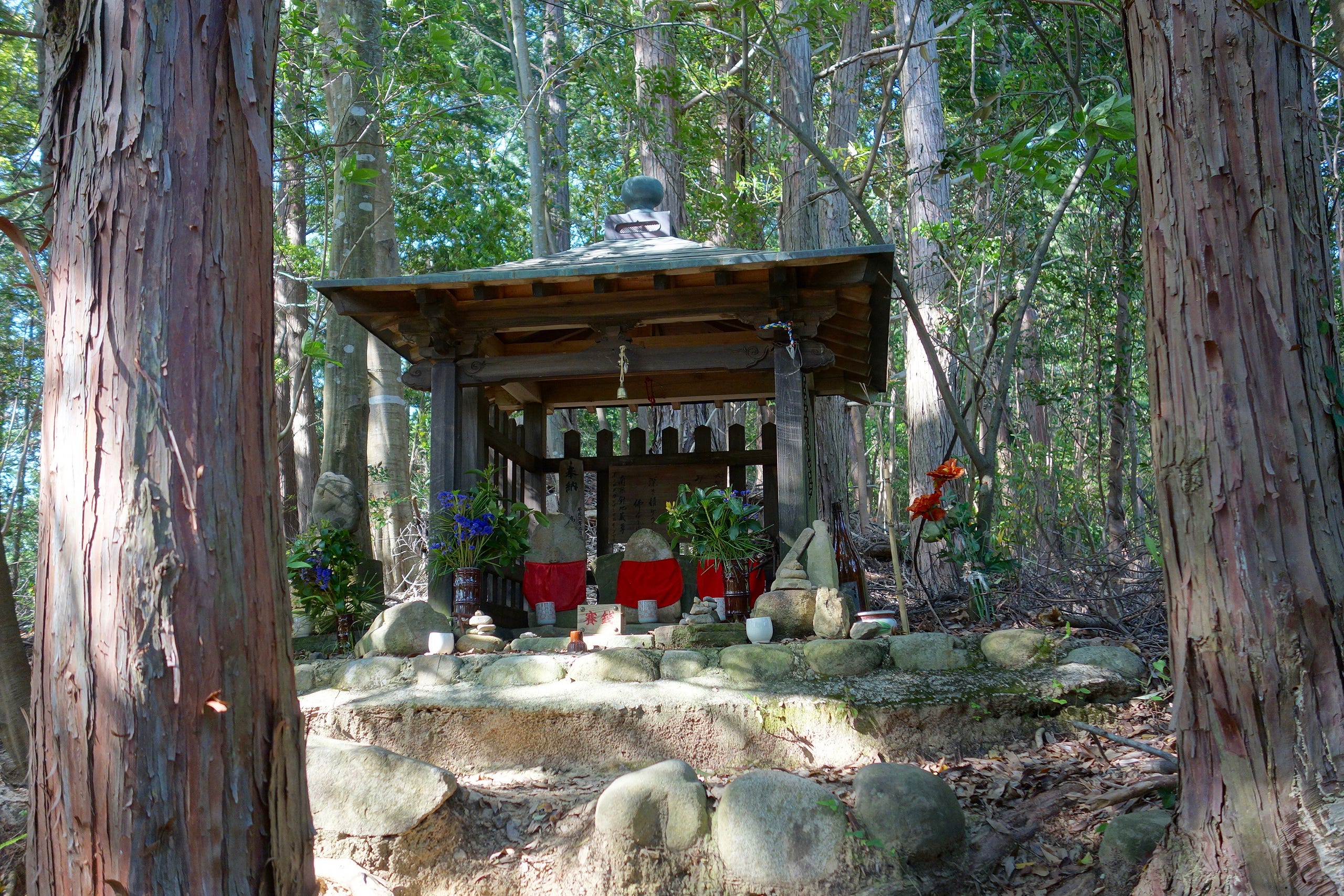
The trees changed from broad-leafed maples and beeches to cedars, cypresses, and pines as we climbed past forest shrines, about one per kilometer. We finally topped out on a ridge with good views across the Tonda River valley. To our surprise, the ridge also featured a string of small farms and gardens in leveled-off spots. We encountered one of the farmers spreading tea to dry; he gave us a tour of his small operation which also included a woodshop where he made furniture from the local cypress. It’s hard to believe that his enterprises supported him, and his homestead seemed much too remote for commuting to a cash job. Yet his house was substantial and well-kept; there was no sign of rural poverty afflicting him or his neighbors.
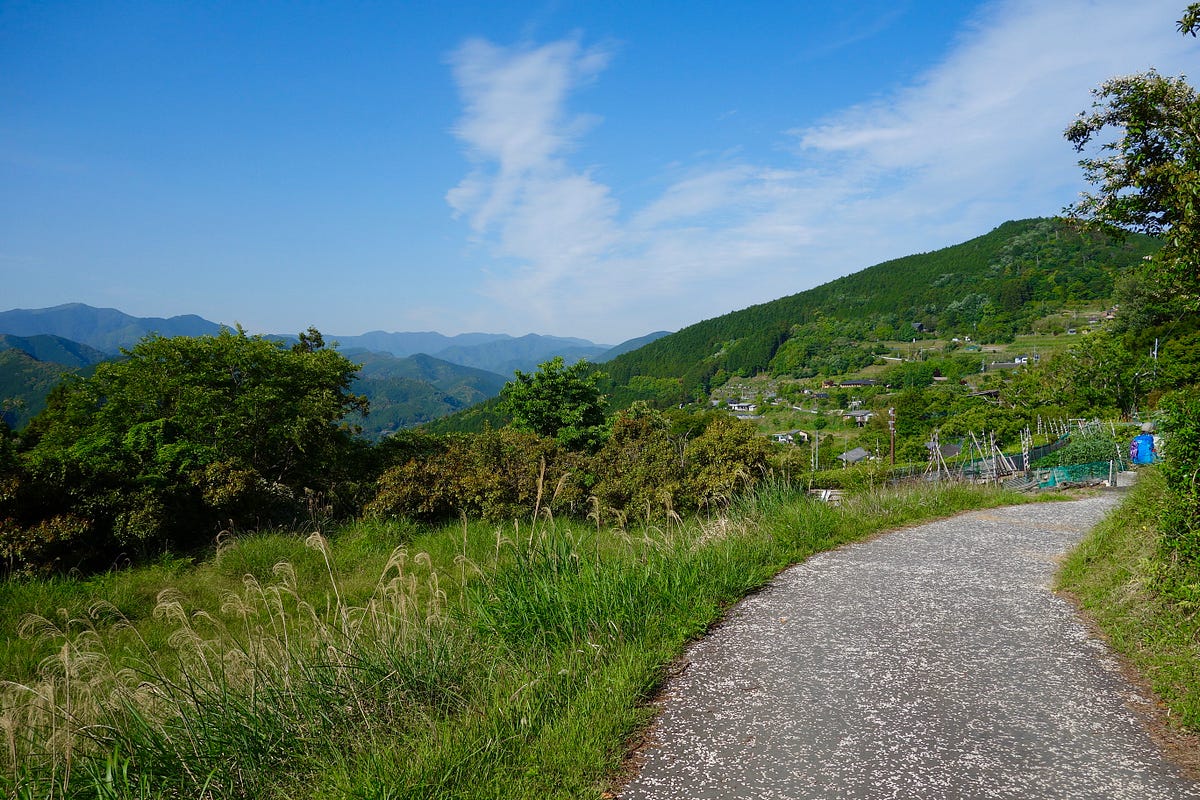
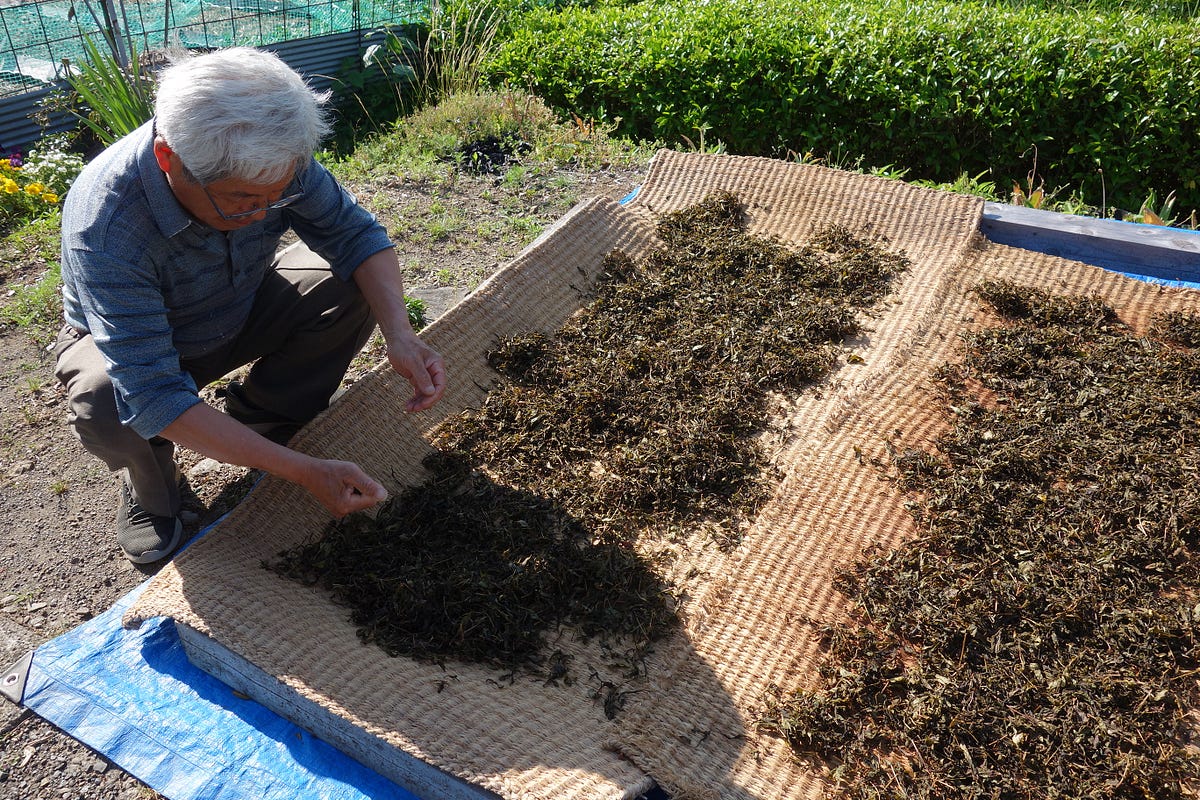

The mountain village of Takahara was delightful: the tidy little farms, the far-reaching views, the clear, cold stream coursing along the walkway between the houses. We would have loved to stay the night there, but our itinerary (we hired Oku Japan to make arrangements) directed us down to the village of Kurisugawa in the valley below. We walked down the path through a forest of tall cedars feeling a bit disappointed.
Our disappointment did not last. The host at the ryokan (Japanese B&B) welcomed us in, bade us remove our shoes (of course) and showed us upstairs to our room paneled with clear spruce and decorated with elegant paintings, calligraphic poems and exquisite carvings. Rectangular reed mats comprised the floor. Sliding paper doors opened out to a screened veranda overlooking the river. The only furniture was a small table; the openness and simplicity of the room focused attention on the quality of the few furnishings and gave rise to a sense of serenity and calm. We were given robes, towels and a pot of tea and were made to understand that we should enjoy a few minutes of relaxation on the veranda before our bath.

Baths are a big deal in Japan, another of the social hacks that enable the Japanese to live in a high-density, high-conformity society without driving each other crazy. Bathing is a ritual and meditative experience and is not a time for socializing, at least not with strangers. The ritual begins with getting scrupulously clean before getting in the bath. The usual set up provides a faucet or showerhead at waist height, a low stool, a bucket, a large washcloth/small towel and plenty of soap. You squat naked on the stool, lather up, scrub all over with the washcloth, then rinse thoroughly while also refraining from rudely spraying your neighbor.
We were in a private residence rather than a public bath, and so the bath was a small two-person affair suitable for couples. It should not surprise you to learn that getting spanking clean after a hot sweaty hike and then soaking in a tub with your sweetie is an ideal way to wrap up the day’s activities.
It is also a pretty great way to get relaxed before dinner. Especially when that dinner is prepared by people who are really really good at it. We had maybe a dozen small dishes set before us. Some were readily recognizable, like the rice and the miso soup that are part of every meal in Japan. The tuna sashimi, shrimp tempura and octopus (an unfortunate inclusion as these creatures are too intelligent and emotional to eat) would also be familiar to anyone who has eaten at a Japanese restaurant in the US. The small fish and myriad pickled/fermented plants and mushrooms were a mystery, but no less delicious for that. It was not just the best meal we ate in Japan, it was one of the best meals I have eaten in my life.

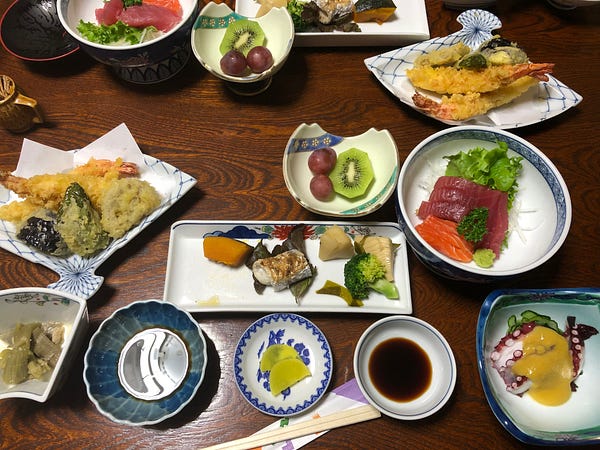
Retiring after dinner, we found (as is the custom) that our tea table had been moved to the side and that futons topped with a light down comforter were laid out for our rest. American futons tend to be 4–6 inches thick, presumably to provide a more mattress-like sleeping experience. Japanese futons are typically 2–3 inches thick, which facilitates rolling them up and putting them away. Despite their relative thinness, we found them plenty comfortable. I also liked the pillows, which are stuffed with buckwheat, rather than feathers or foam.

Day 2 — Takahara to Nonaka, 13 km
After a fine breakfast of fish, rice, and fruit, we presented our hosts with the tea and chocolate made in our home town (Boulder, CO) that we had brought for gifts, and then jumped in their tiny car for a ride on an even tinier road back up to Takahara, saving us a roadwalk climb of 300m.
We followed the pathway up beside a stone-lined irrigation ditch that fed small rice paddies, then turned up a ravine through tall dense forest to a divide at about 700m.
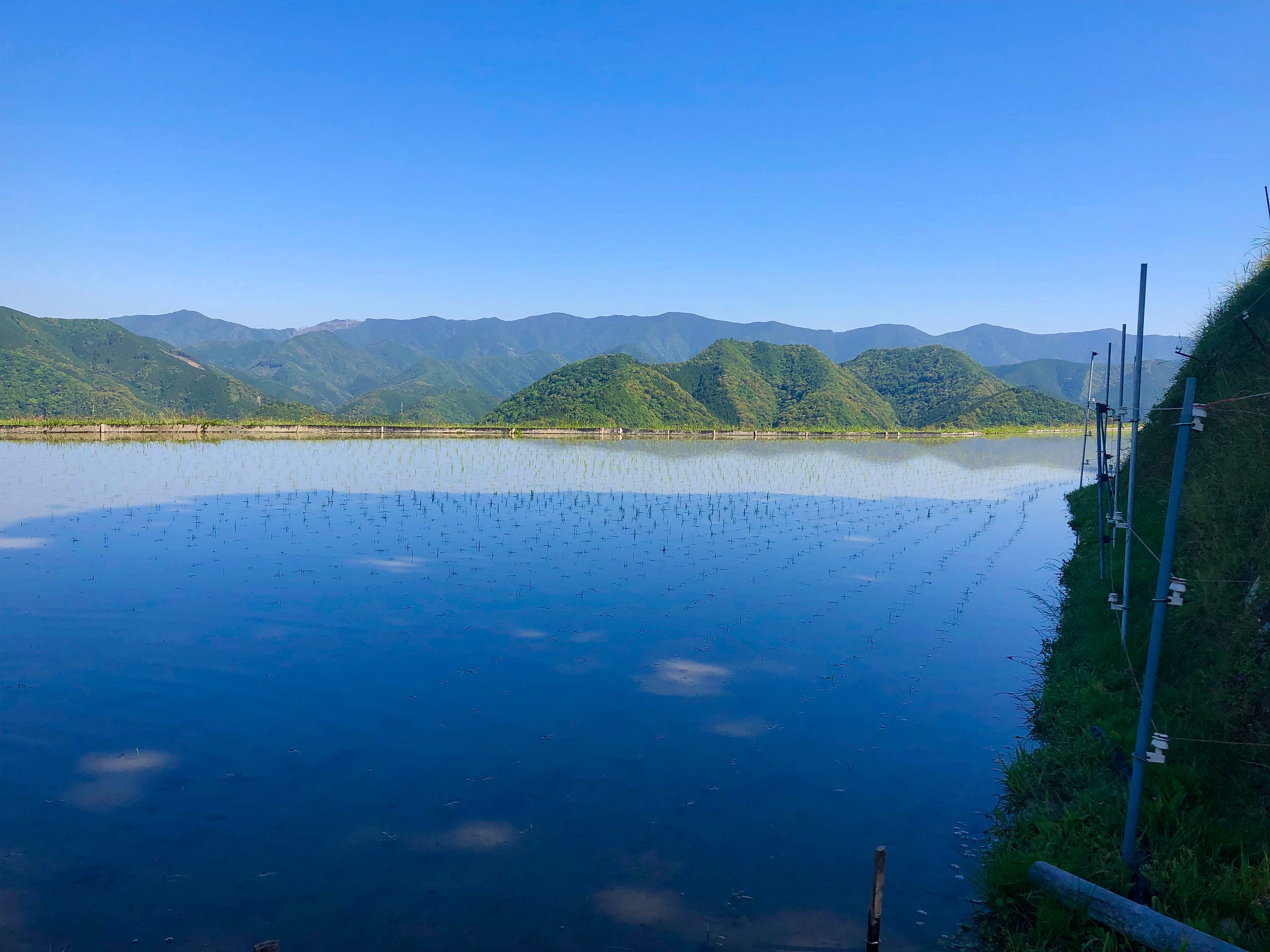
Switchbacks aren’t really a thing in Japan. If the mountains are steep (and they are) then the trails are steep. On the other hand, paving trails is common, an improvement which makes a good deal of sense in a humid country with loose soils. I can imagine that these trails would become muddy impassable quagmires after just a couple days of rain.
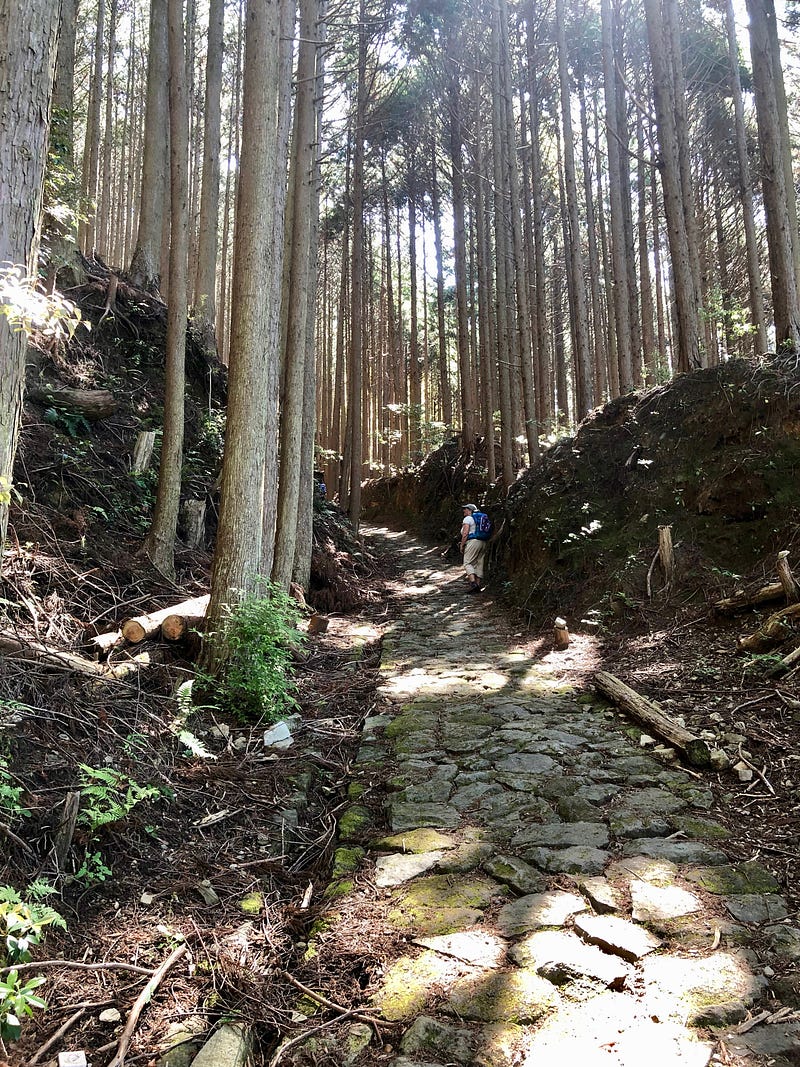
We followed the ridgeline for a while, our views of farther mountains filtered by the forest. We encountered more shrines, a few of them rustic and seeming quite at home among the trees.
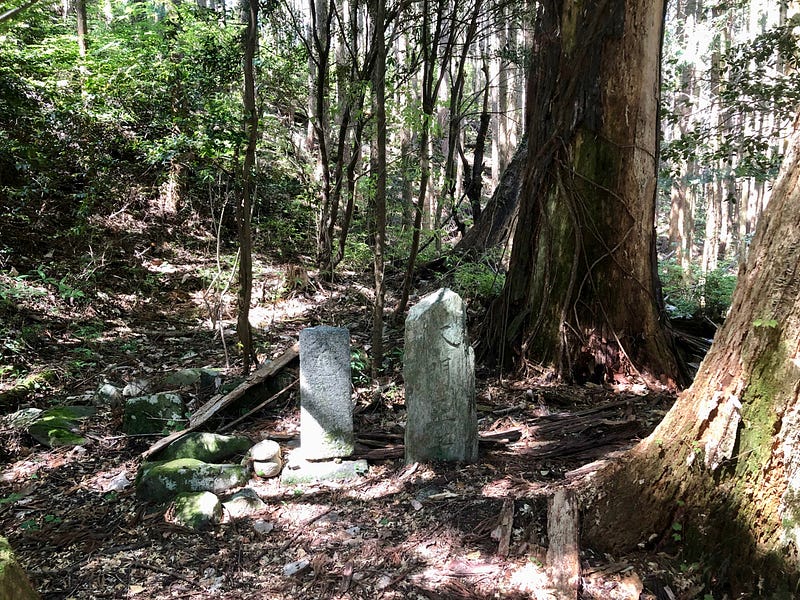
Most shrines showed signs of recent upkeep — they were in good condition, swept free of leaves and brightened by the placement of cut flowers and clean tea cups. Since most of them are several strenuous kilometers from any road, this upkeep is not a trivial undertaking. The Japanese are among the least-religious people in the world, yet they find the time and funds to maintain many many thousands of shrines throughout the country, even on remote trails like this one. I can only speculate that it is a passion for order, or perhaps a reverence for tradition that drives this effort. The result is a trail which constantly reminds you that you are just one of many travelers to pass this way, no more important and no less. You are part of a community of pilgrims and shrine-keepers, both past and present, that is mostly unseen but very much real.
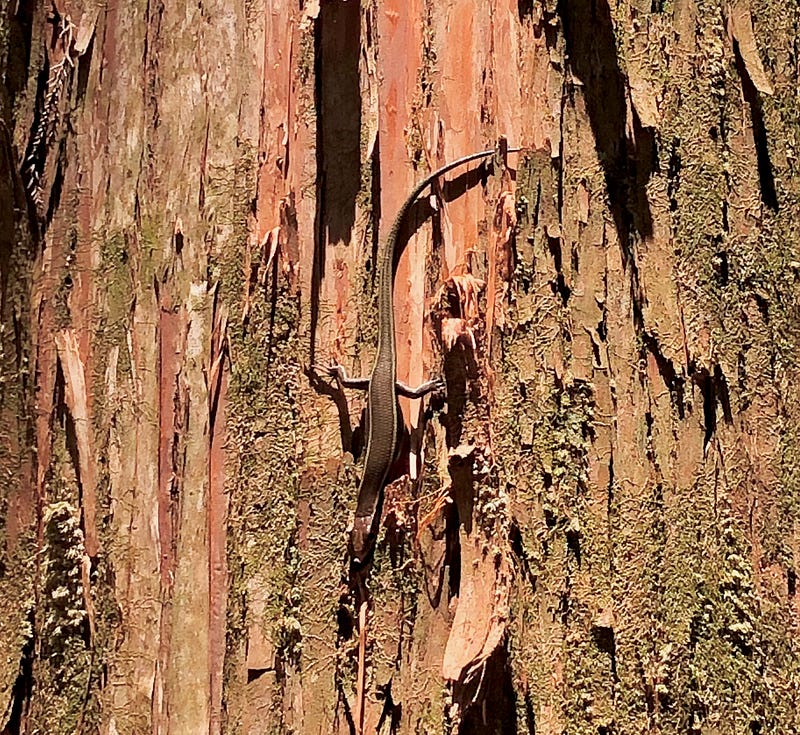

We began the long descent from the ridge and stopped at a shrine next to a small creek for lunch. Our hosts had packed us bento boxes, which we enjoyed under the shade of large cedars while watching a lizard (perhaps a skink?) probe beneath the papery bark for insects. A bit further on we emerged from the forest on to a highway which featured a rest stop with a convenience/souvenir shop. A few hikers clustered outside on picnic tables, so we did the neighborly thing and bought a cold beer and joined them for a break.

A climb over a low ridge brought us in view of Chikatsuya, a pleasant village along the Hioki River, whose waters are thought to purify passing pilgrims. The village is large enough to support a couple of convenience stores. Not knowing if our lodgings for the evening would have beer, prudence dictated that I buy an Asahi tallboy just in case.
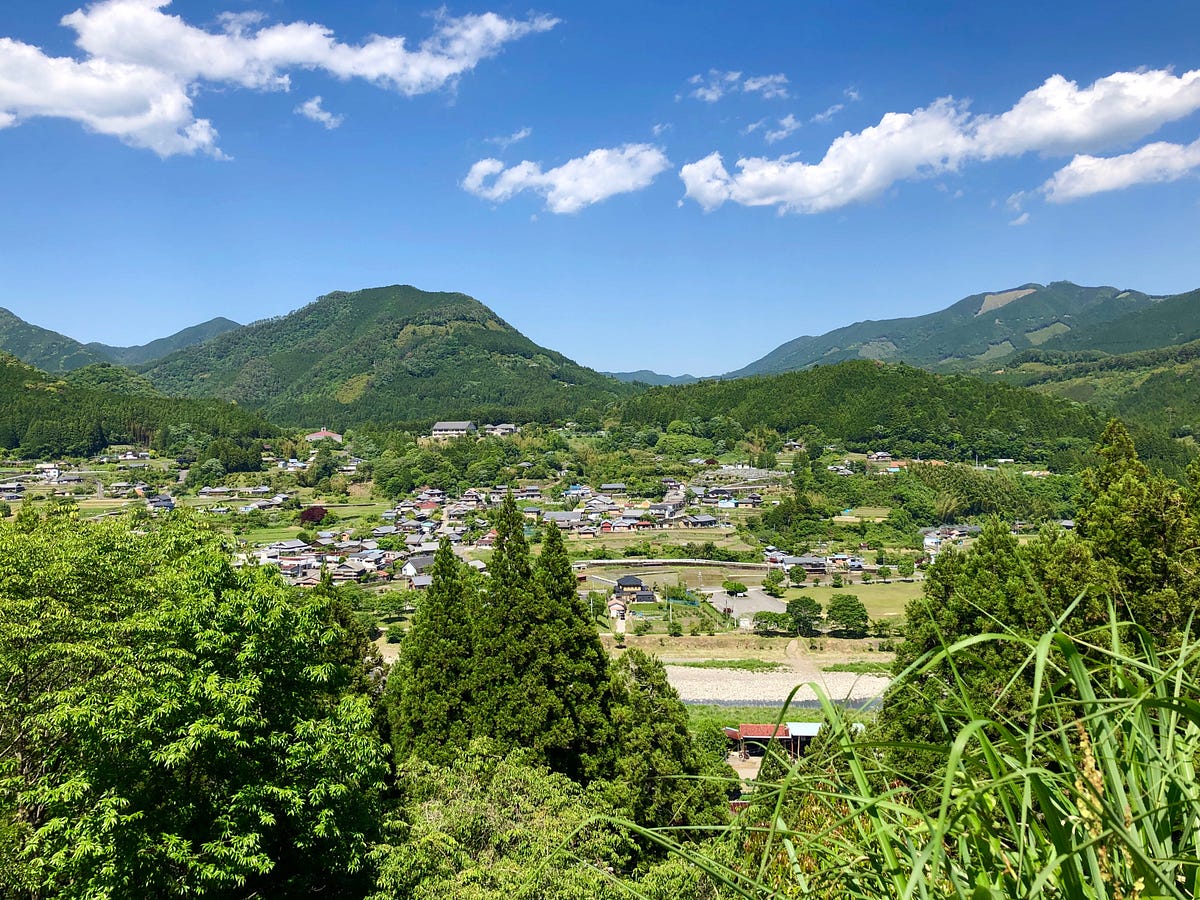
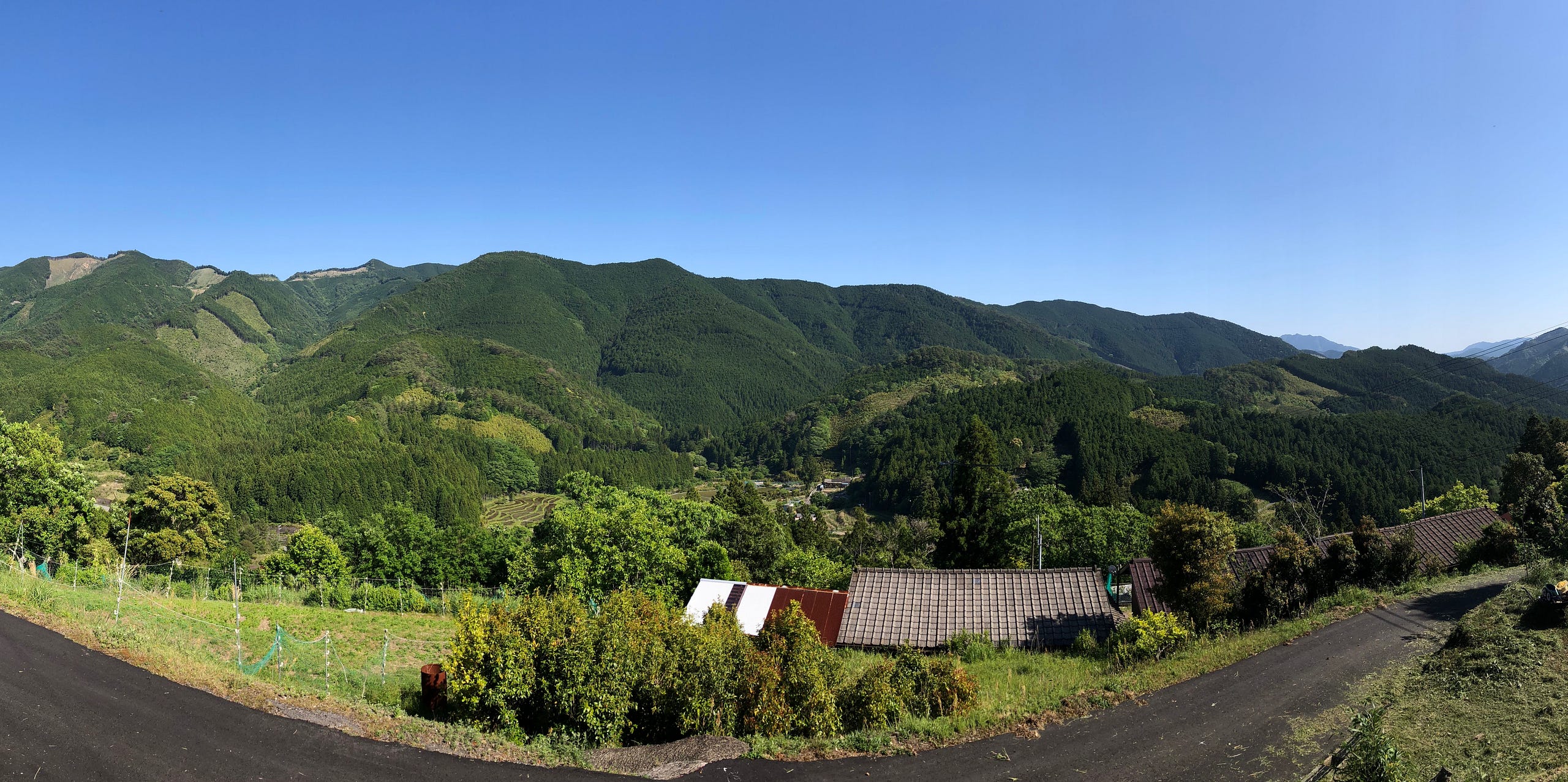
The rest of the day’s journey was a hot and humid roadwalk up on the ridge above the valley. Our ryokan, the Nonaka Senso, was located down on the valley floor, making the ridge climb seem pointless. But we arrived at the inn soon enough, albeit hot and bedraggled, and were shown to our quarters, a spacious but somewhat barn-like outbuilding along the river. A robe, a cold beer (it’s better than hot tea, sorry Japanese hosts) and a bath prepared us for dinner. Close to a dozen hikers, mostly Australian, were present. Although the food was not as good as the previous evening’s fare, it was a respectable showing and we retired well-fed.
Much of the evening’s conversation revolved around the question of route options for the next day. The full hike to Hongu Shrine, one of the principal shrines along the route, is about 25 km long with 1200m of climbing. Typhoon damage to the trail necessitates a detour that adds a couple km and another 300m climb. Not everyone was up for this. In fact, no one was, except for me, and Lisa, a terrorism-preparedness consultant from Minneapolis. We arranged a ride back up to the trail (avoiding an additional 300m roadwalk climb), while the others planned on using the local bus to cut the hike to either 15 or 7 km, depending on how far they rode. Cathy was feeling satisfied that she had hiked up enough steep hot forest trails, at least for the time being, and joined up with Nancy from Hawaii to hike the short option.
Day 3 — Nonaka to Hongu Taisha, 27km
Lisa and I set out directly after breakfast, not wanting to keep our bus-riding companions waiting too long for us. We climbed steadily past small farms, houses and schools, engaged in pleasant small talk. The road gave out and the trail steepened as we approached Waraji Pass, with gaps in the conversation opening as we huffed our way uphill. Waraji are traditional straw sandals worn by peasants. They are as durable as one would expect straw sandals to be, and a fresh pair would last about from Chikatsuya to this pass, where they were left behind (no doubt neatly arranged) and another pair put on.

The far side of the pass hosted an especially impressive cypress grove. Lisa decided to stay and meditate, I chose to push on. I soon came to the well-marked detour and began a 300m climb up a ridge deemed steep enough to warrant putting switchbacks on the trail.
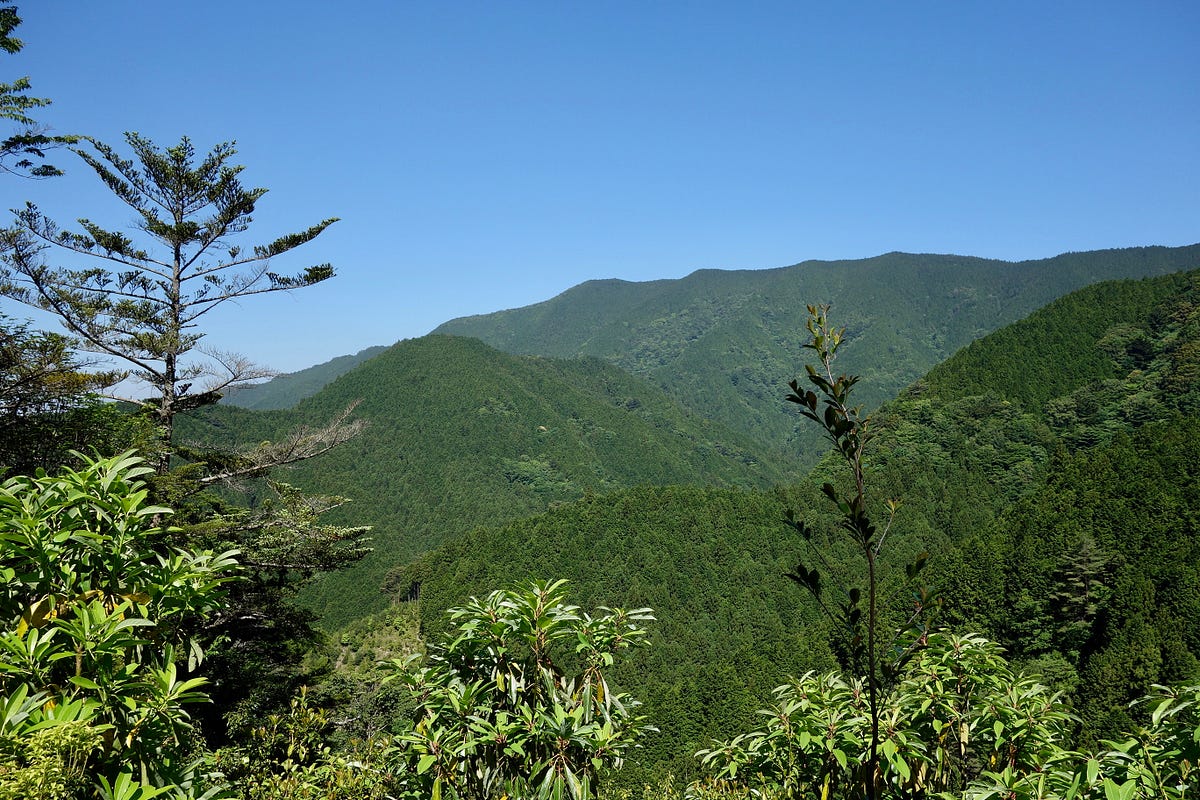
The trail continued to pass shrines of various size every kilometer or so. A few of these sported spring-fed fountains, and I adopted the Buddhist practice of purification: pouring water over the left hand to clean it; then the right hand; then drinking water from the left hand to clean one’s mouth. It’s a practice that is not too different from what I do when encountering a beautiful natural spring in the mountains or desert. Drinking the water — water unadulterated by filtration or chemical treatment — is a good way to enlist an additional sense in connecting to the land. And connection is ultimately what all religions are really about: connecting to communities both living and dead, connecting to forces that we don’t understand, connecting our lives to greater lives in hopes that death won’t be the end.

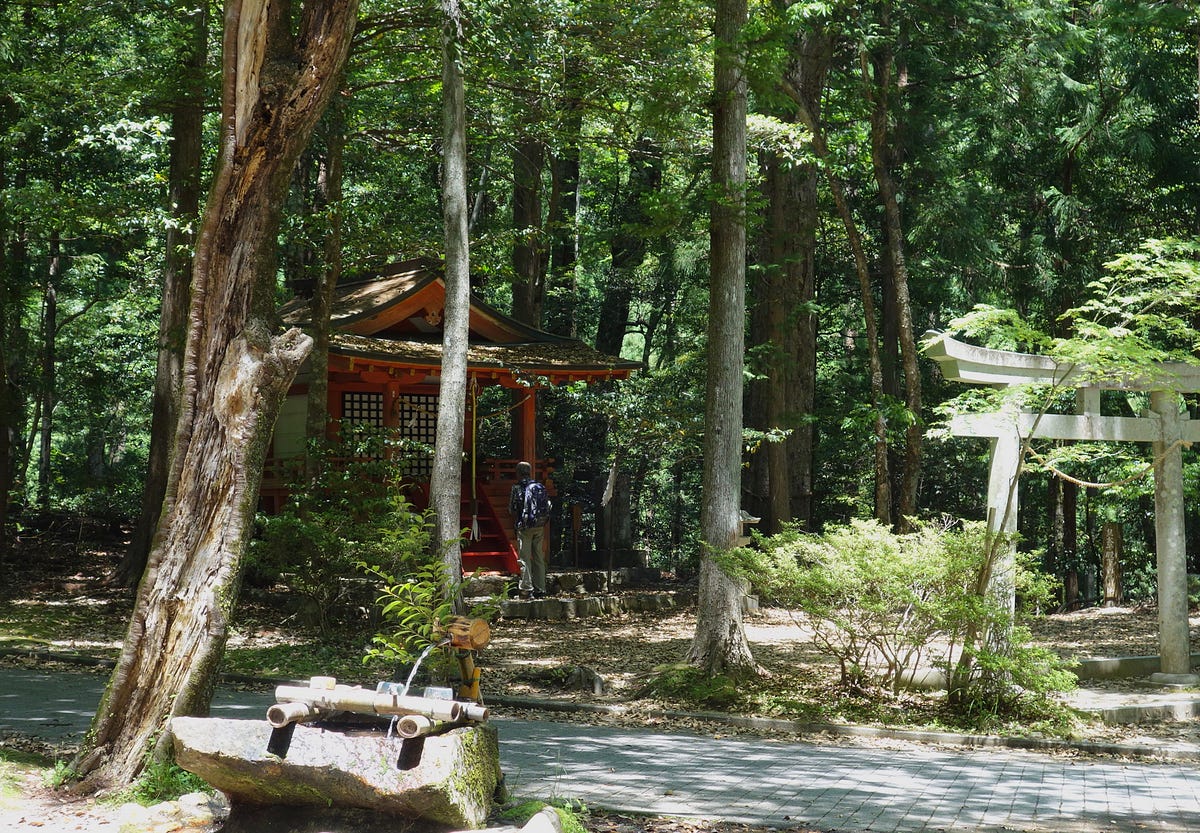

And here on the Kumano, despite having no particular interest in its religion, I felt connected. Thousands of people over thousands of years have come this way. The lives of most of them are about as different from mine as human lives can be, but humans really don’t vary that much. We tend to focus on minute differences, both in a positive way (yay for diversity) or a negative way (hail to the volk). But the fact is we are far more alike than different, as befits a species with a genome that is 99.5% identical among all its members. We all came this way for much the same reasons.
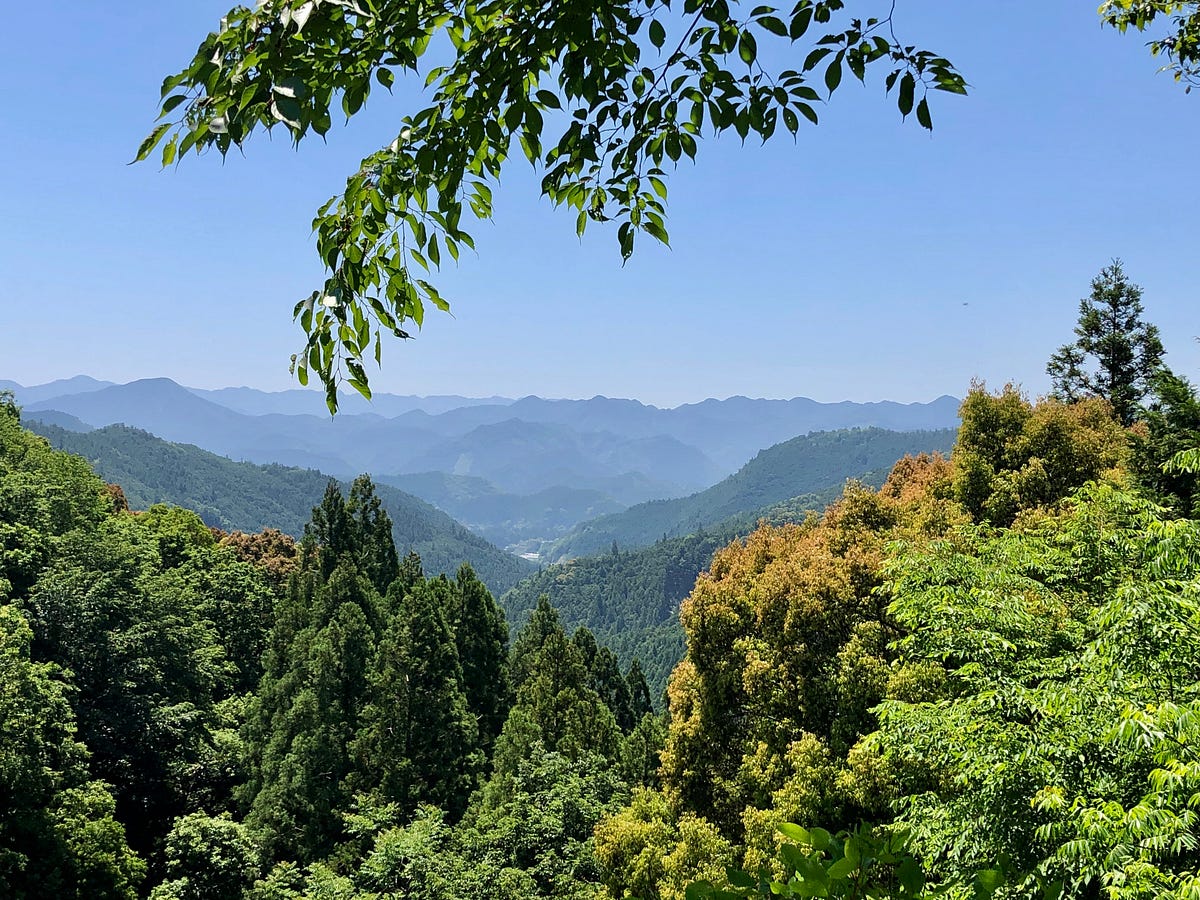
The trail began dropping off the ridge, revealing views of the valley of the Hongu Taisha. I lunched at the Hoshinmon-oji, a shrine that marks the outer limits of the sacred Hongu district, and began seeing more Japanese pilgrims, enough to outnumber the Westerners for the first time.
Out of the deep forest, the trail passed small settlements and scattered farms, and became much more domesticated and inviting.
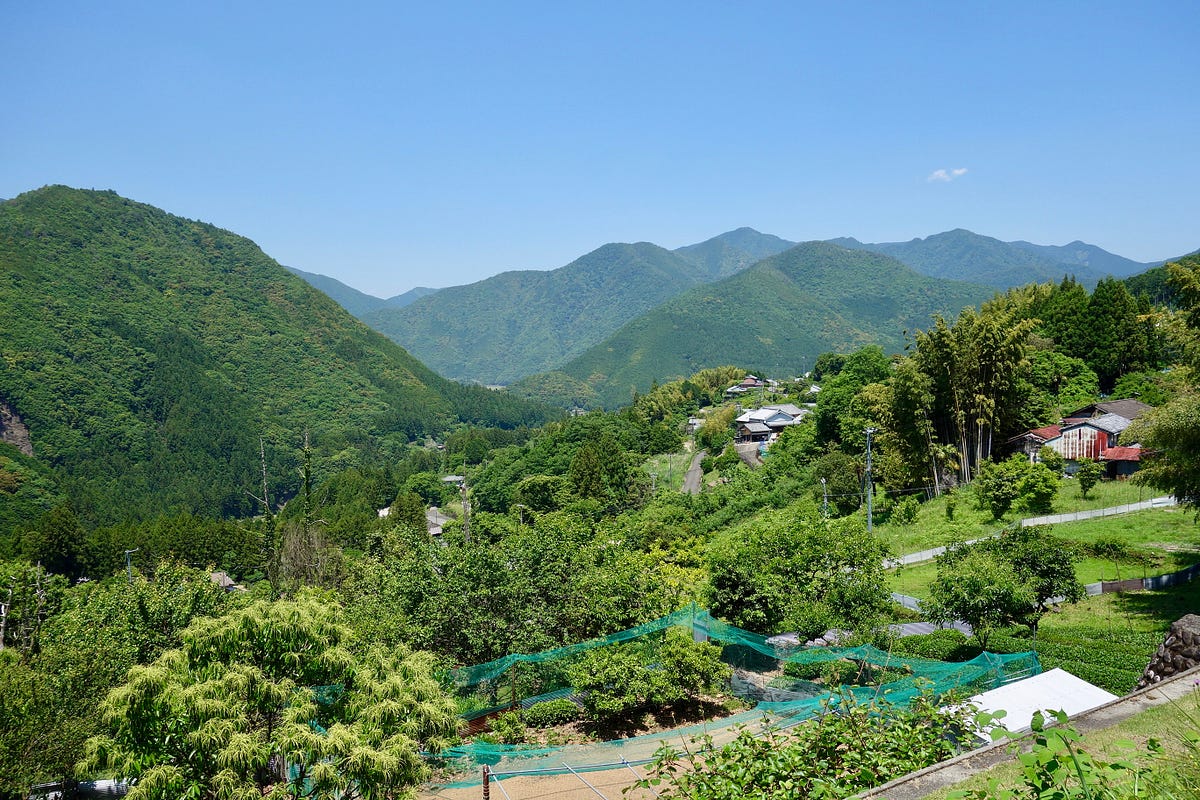

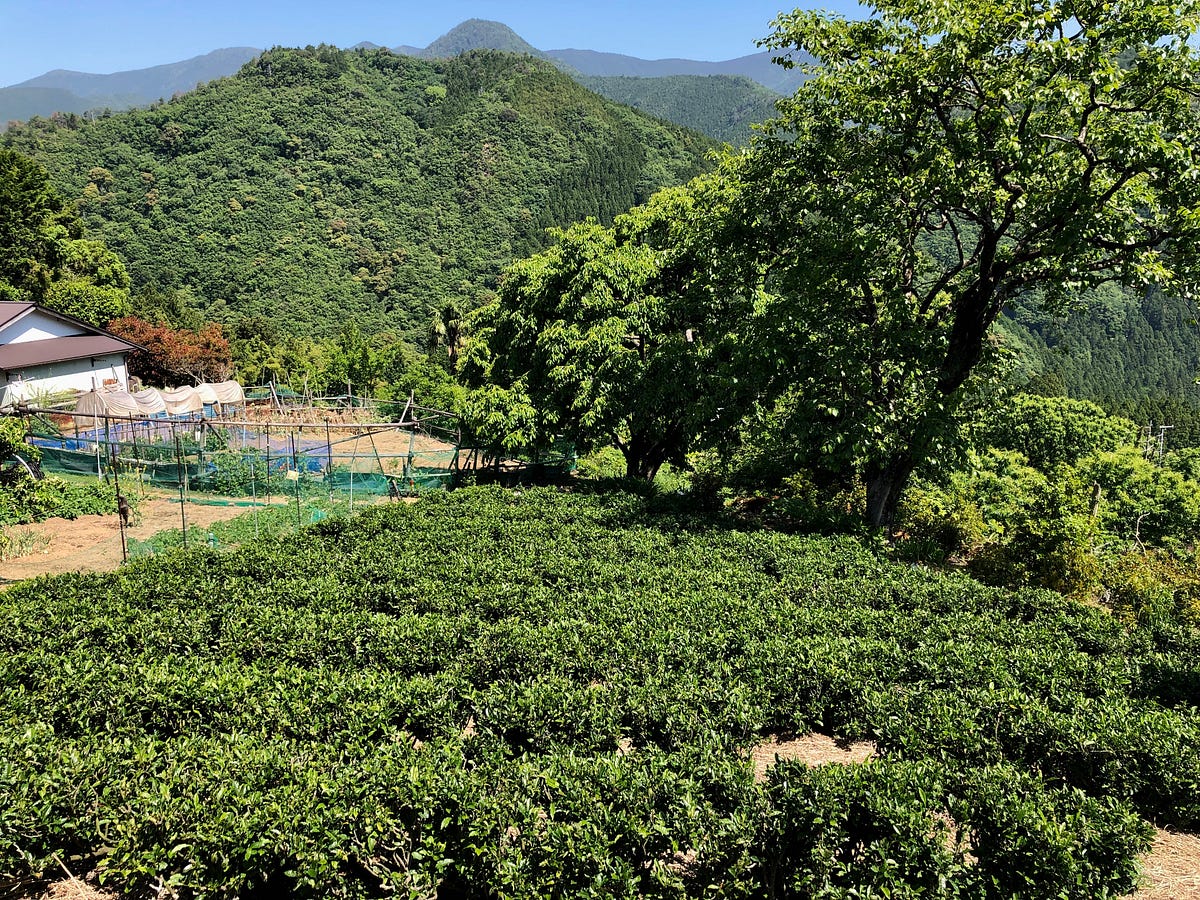


The trail emerged into civilization at the Hongu Taisha shrine, well-visited and supported by a small town and highway. I poked around the shrine complex a bit, looking for Cathy. Not seeing her, I descended the long staircase from the hilltop and walked down to the riverbed site of the original shrine, now home to a park and to the world’s largest torii.

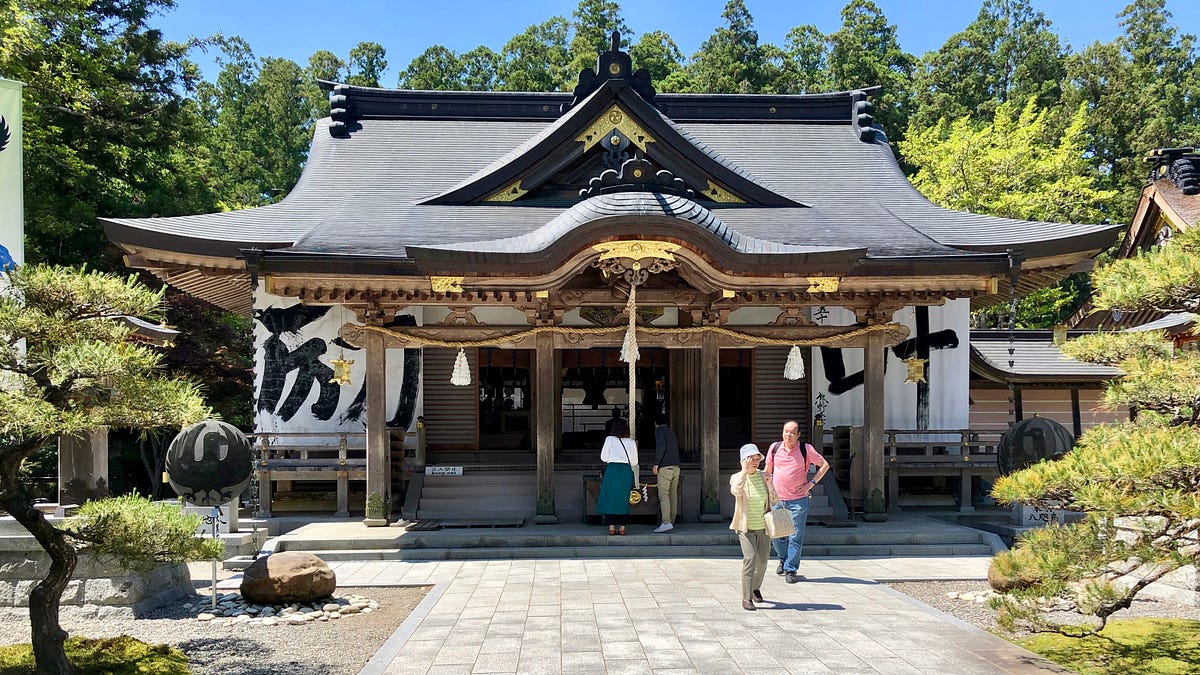
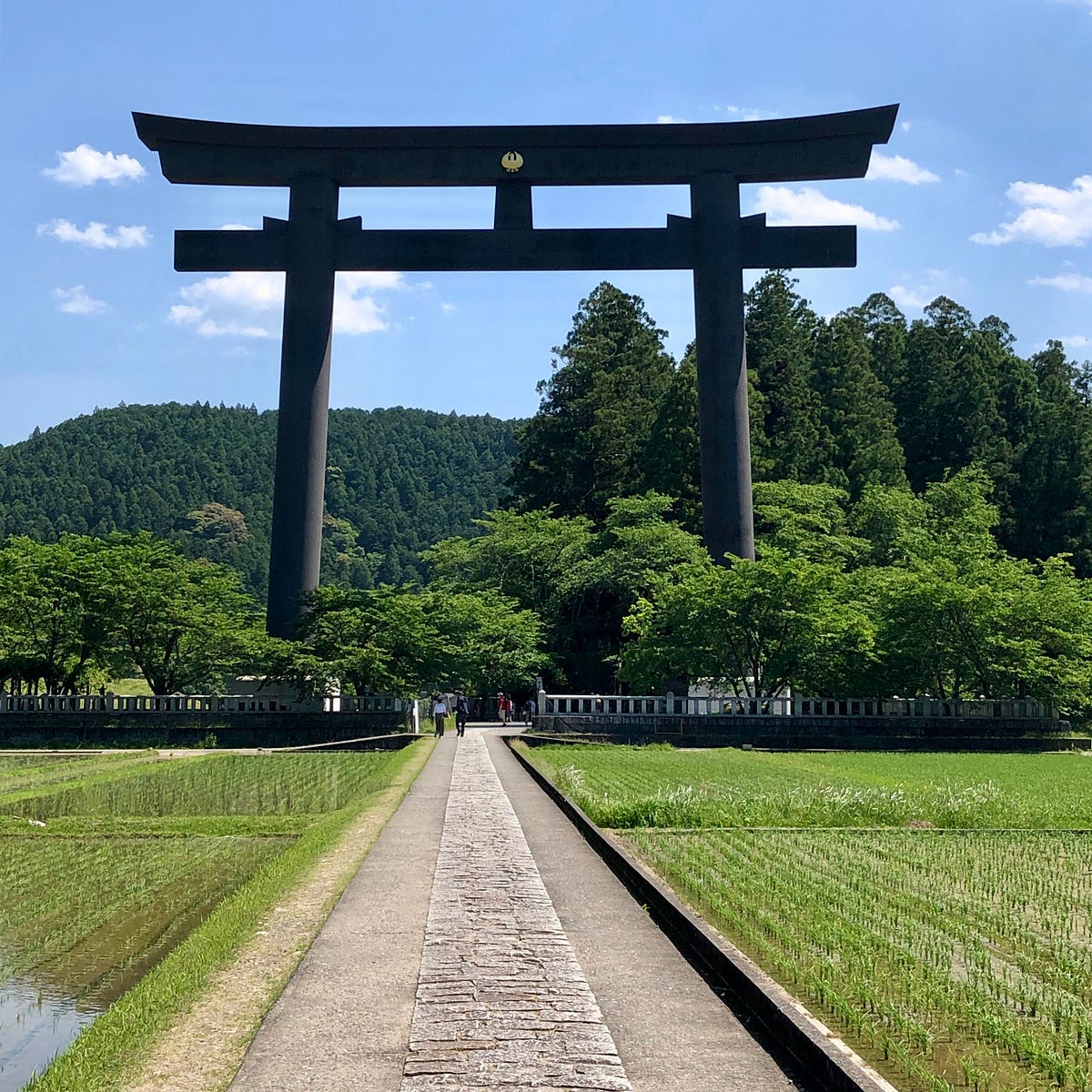
I found Cathy back at the shrine, relaxing and reading a book. Our accommodations were not in Hongu, but at Kawayu Onsen, a hot springs resort reached by a 15 minute bus ride. It featured both indoor and outdoor spring-heated baths, as well as riverside hot springs, and of course, great (if somewhat mysterious to us) food. I think there is a fair chance we ate brains at some point.
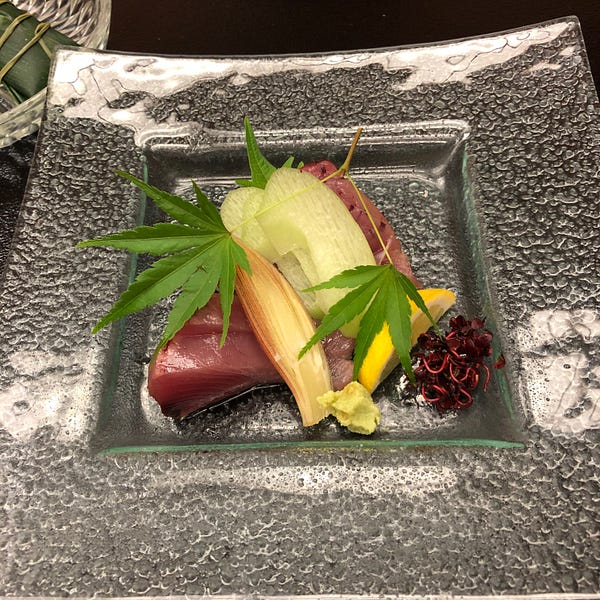
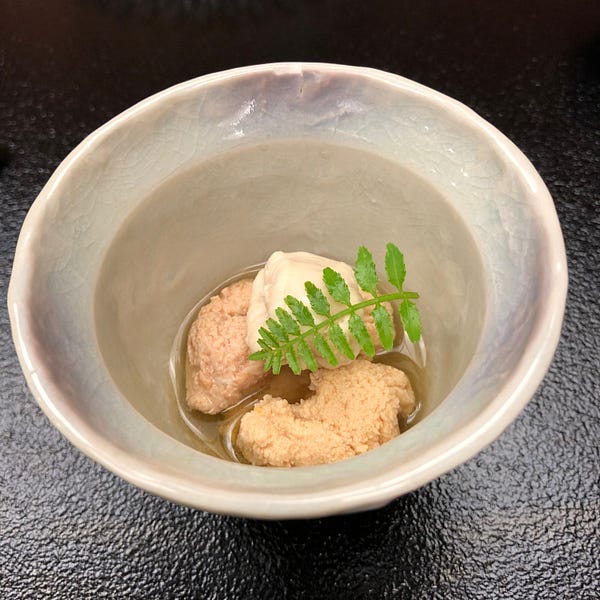

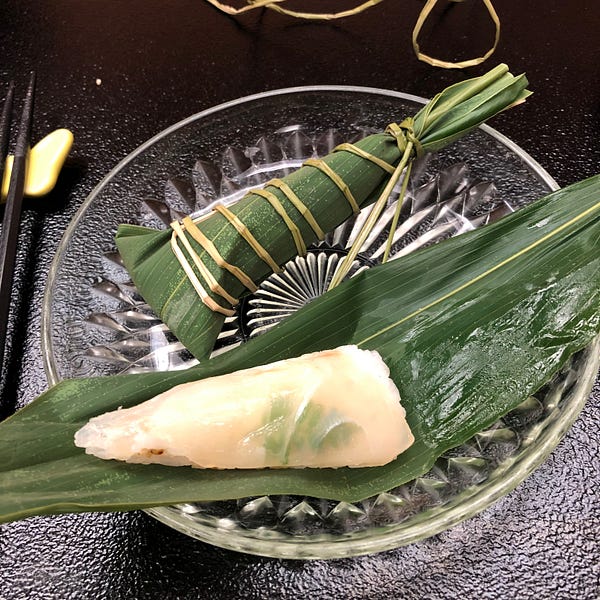
Given the presence of hot springs, we thought it best to take a zero day. We went back to Hongu the next morning for a lesson in traditional Japanese paper-making, then returned to spend the afternoon hanging out along the river.




Warm water constantly seeps up through the gravel of the river bed. All you need to construct your own hot tub is a shovel (supplied at the front desk) to dig out a depression. Warm water infiltrates, and you are all set. When it got too warm, a quick plunge in the cool river was sufficient to restore thermal equilibrium and ready us for another round of soaking. Pretty sweet setup.
Day 5 — Koguchi to Nachi-san, 15 km
For some reason, our itinerary skipped the next section of the trail (Hongu to Koguchi), and we were transported by taxi direct to Koguchi to begin walking. Uphill, of course. This section includes the high point of the Kumano Kodo, and features about 1000m of total elevation gain.

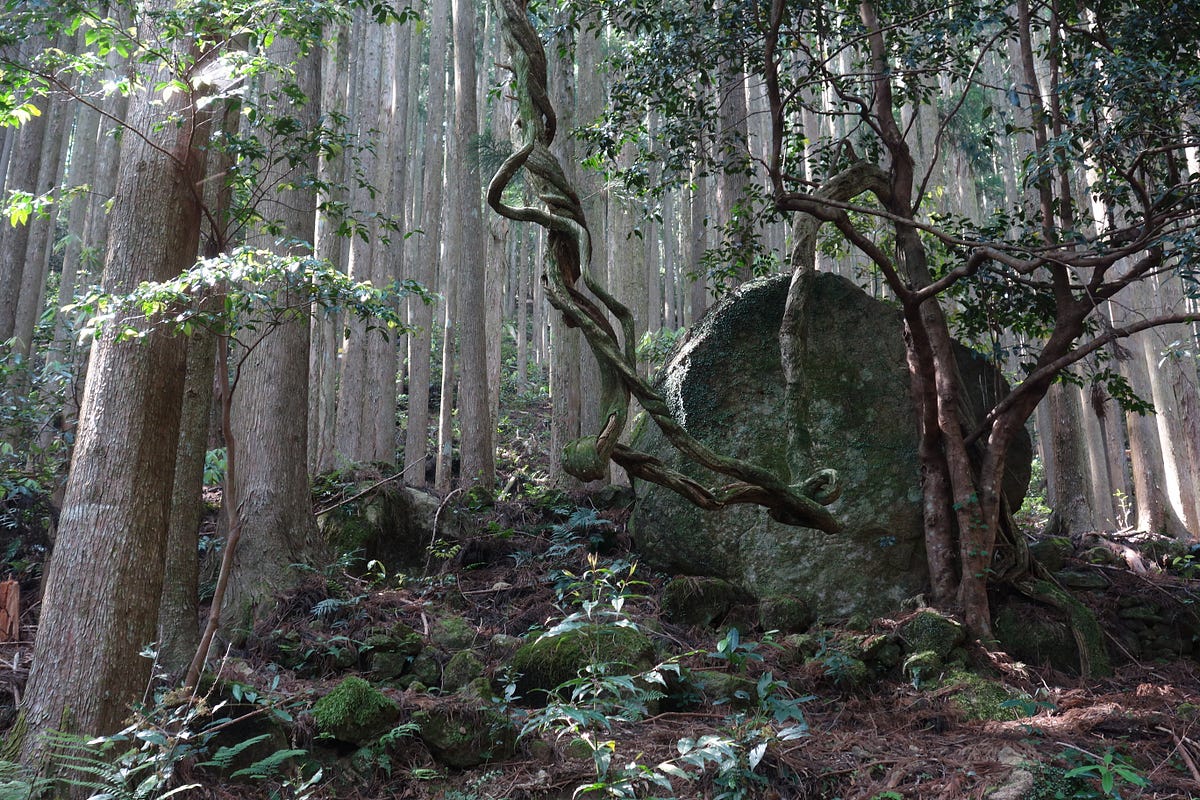
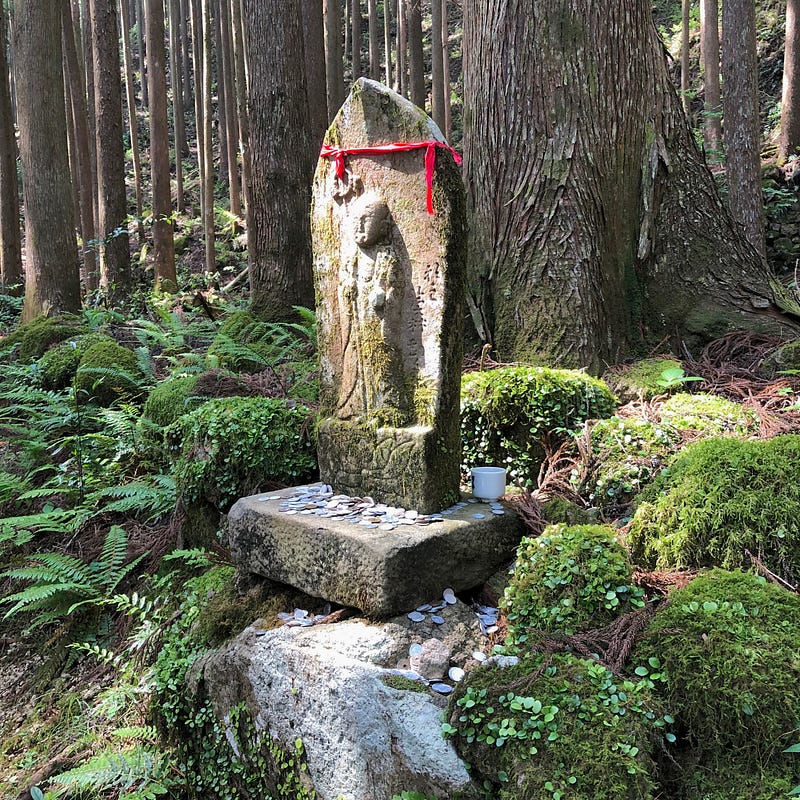
Japan was experiencing record-high temperatures for May, making the climb all the more sweaty. But there was no need to hurry, we had plenty of water and a good lunch, and enjoyed the walk as best we could.
Being forested, the view from the top was pleasant, but not spectacular. The ocean could be sorta kinda glimpsed through the trees and the haze, but much was left to the minds eye in filling out the view.
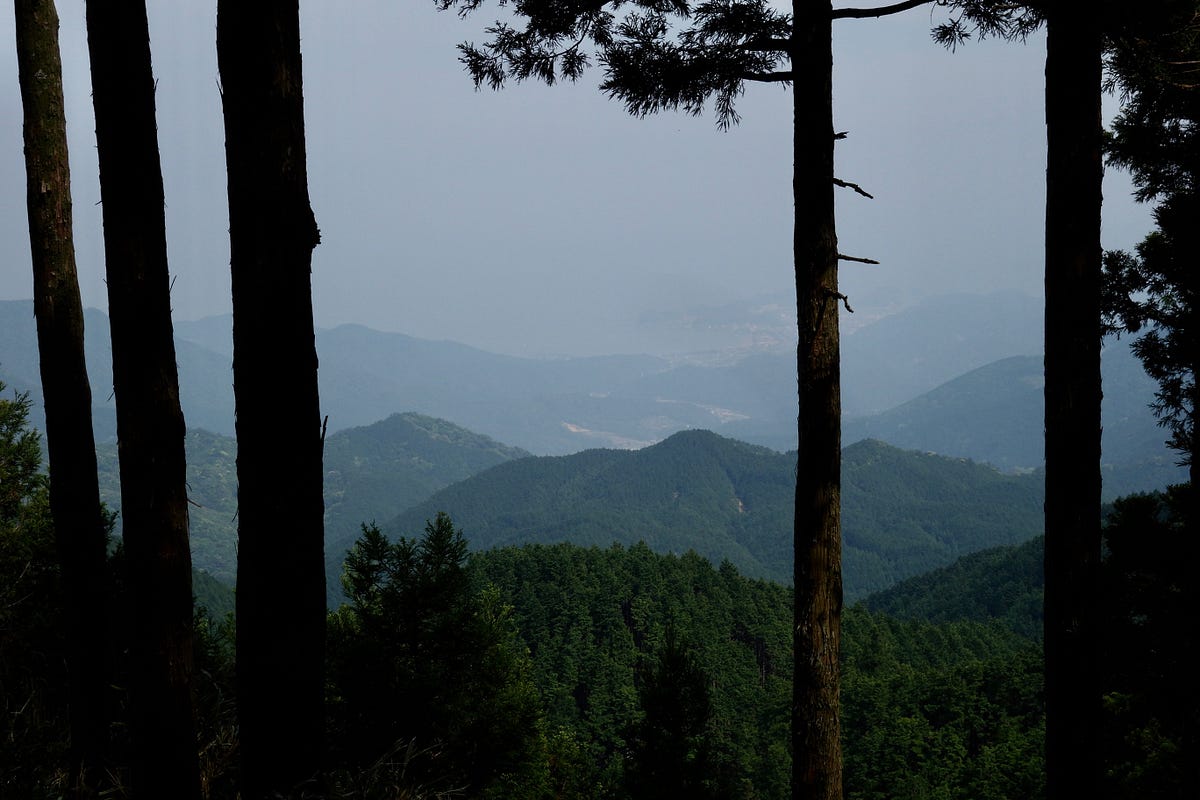
The signage, once again, bound up our experience with that of other travelers over the centuries.

The climb down to Nachi-san was just as steep, and for Cathy, even harder and slower. I longed to race ahead to claim the cold beer that I just knew was waiting for me, but that would hardly have been fair or compassionate. Another lesson from the trail.
We did finally emerge from the forest to end our hike at the grand shrine at Nachi-san, enlivened by views of its beautiful orange pagoda and the Nachi-taki falls, some 130m high, making it the tallest waterfall in Japan.

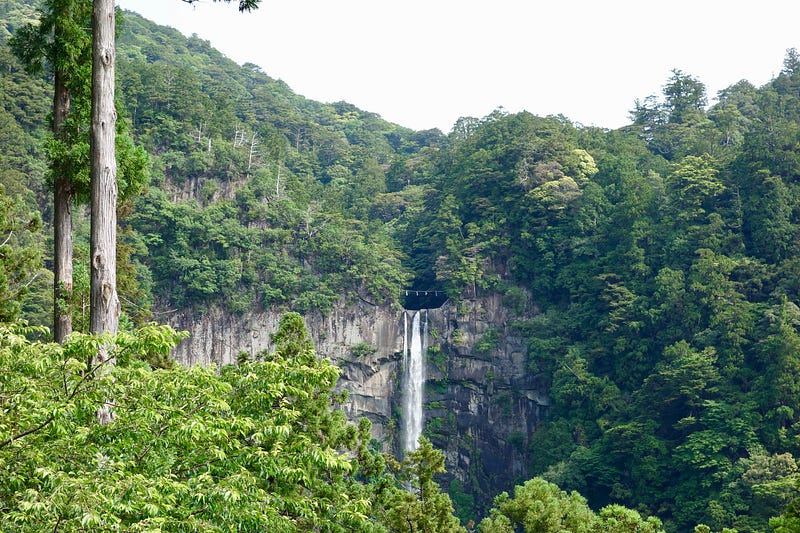
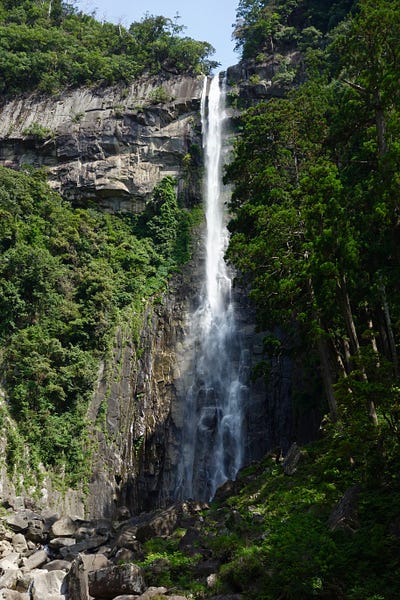

Walking the Kumano Kodo is an experience unlike other long walks. Trails such as the PCT or the Camino tend to develop spontaneous organic communities, a sort of instant tribe. The combination of slow pace and shared experience give people a chance to discover that they have more in common than their destination. I saw no sign of this dynamic on the Kumano. It seems instead a much more individualistic experience. Maybe this is just a function of the sparseness of hikers, or the relatively short time needed to complete the trail. But I think there is more to it than that.
Westerners traditionally seek spiritual experiences in congregations — think of our cathedrals or megachurches. Japanese religious practices certainly have their group activities (just as Westerners have hermit traditions), but they seem to tend much more toward solitary and meditative experiences. The Kii Peninsula, whose rugged topography bars the dense settlement found in the lowlands surrounding it, is naturally set apart and separated from the rest of Japanese society. It is not a place for crowds, orderly or otherwise. The Kumano doesn’t sport open cathedrals of rock, ice, and sky like the John Muir Trail, or the empty desert cactus-scapes of the Arizona Trail. Its curtains of cedars — and long steep climbs — instead offer a chance to escape the surveillance of society, a powerful draw for those who feel their own core selves being smothered by the demands of group harmony. This was true a thousand years ago; it is true now. It will be true whenever you feel the need to walk the Kumano. And when you do, it will be there waiting for you. Some trails go on forever.
.
